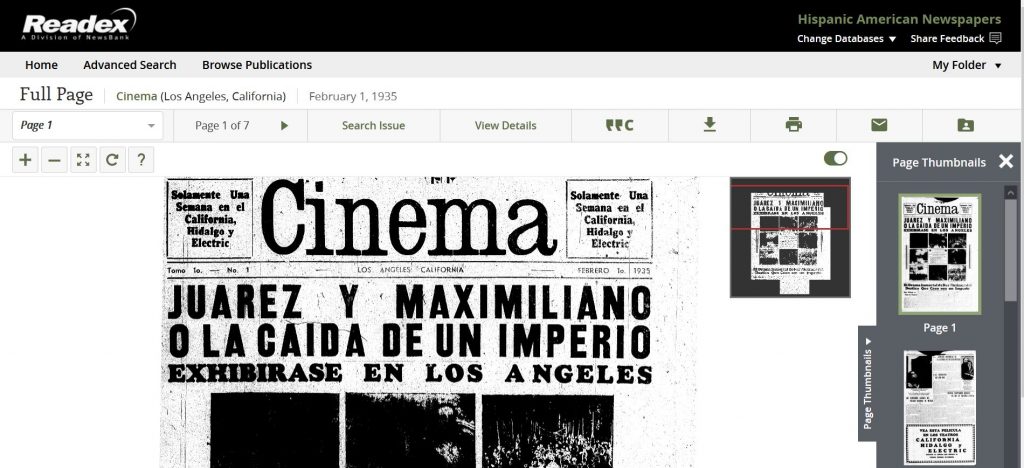Tag: newspapers
The Bancroft Library’s San Francisco Examiner photograph archive
As part of the UC Berkeley University Library’s ongoing commitment to make all our collections easier to use, reuse, and publish from, we are excited to announce that we have just eliminated licensing hurdles for use of over 5 million photographs taken by San Francisco Examiner staff photographers in our Fang family San Francisco examiner photograph archive negative files, BANC PIC 2006.029–NEG, and Fang family San Francisco examiner photograph archive photographic print files, BANC PIC 2006.029–PIC.
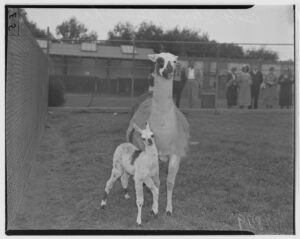
Every photograph within these photographic print and negative collections that were taken by an SF Examiner staff photographer are now licensed under a Creative Commons Attribution 4.0 license (CC BY 4.0). This means that anyone around the world can incorporate these photos into papers, projects, and productions—even commercial ones—without ever getting further permission or another license from us.
What is the San Francisco Examiner collection?
The SF Examiner has been published since 1863, and continues to be one of The City’s daily newspapers. It was acquired by George Hearst in 1880 and given to his son, William Randolph Hearst, in 1887. It was the founding cornerstone of the Hearst media empire, and remained part of the Hearst Corporation’s holdings until it was sold, in 2000, to the Fang family of San Francisco. In 2006 the Examiner’s photo morgue, totaling over 5 million individual images, was donated to The Bancroft Library by the Fang family’s successors, the SF Newspaper Company, LLC.
Along with the gift of negatives and photographic prints, the copyright to all photographs taken by SF Examiner staff photographers was transferred to the UC Regents, to be managed by UC Berkeley Library. However, the copyright to works (mainly in the form of photographic prints) that appear in the collection that were not created by SF Examiner staff was not part of the copyright transfer to the University. Copyright to any works not taken by SF Examiner staff is presumed to rest with the originating agency or photographer. The Library maintains a list of known SF Examiner staff photographers and can assist in making identification of particular photographs until the metadata has been updated.
What has changed about the collection?
Although people did not previously need the UC Regents’ permission (sometimes called a “license”) to make fair uses of our SF Examiner photograph archive, because of the progressive permissions policy we created, prior to January 2024 people did need a license to reuse these works if their intended use exceeded fair use. As a result, hundreds of book publishers, journals, and film-makers sought licenses from the Library each year to publish our Examiner photos.
The UC Berkeley Library recognized this as an unnecessary barrier for research and scholarship, and has now exercised its authority on behalf of the UC Regents to freely license the SF Examiner photographs in our collection that were taken by staff photographers under a Creative Commons Attribution 4.0 license (CC BY 4.0). This license is designed for maximum dissemination and use of the materials.
How to use SF Examiner collection photographs
Now that the photographs by SF Examiner staff photographers have a CC BY license applied to them, no additional permission or license from the UC Regents or anyone else is needed to use these works, even if you are using the work for commercial purposes. No fees will be charged, and no additional paperwork is necessary from us for you to proceed with your use.
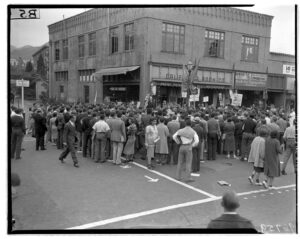
Making your usage even easier is the fact that over 22,000 of these negative strips have been digitized and made available via the Library’s Digital Collections Site, and the finding aid for the prints and negatives have more information about the photographs that have not yet been digitized.
The CC BY license does require attribution to the copyright owner, which in this case is the UC Regents. Researchers are asked to attribute use of reproductions subject to this policy as follows, or in accordance with discipline-specific standards:
Fang family San Francisco Examiner photograph archive, © The Regents of the University of California, The Bancroft Library, University of California, Berkeley. This work is made available under a Creative Commons Attribution 4.0 license.
One final note on usage: While the SF Examiner Collection now carries a CC BY license, this does not mean that other federal or state laws or contractual agreements do not apply to their use and distribution. For instance, there may be sensitive material protected by privacy laws, or intended uses that might fall under state rights of publicity. It is the researcher’s responsibility to assess permissible uses under all other laws and conditions. Please see our Permissions Policy for more information.
Other Library collections with a CC BY license
The Fang family San Francisco Examiner photograph archive joins a number of other collections that the Library has opened under a CC BY license, including the photo morgue of the San Francisco News-Call Bulletin. All of the collections that have had a CC BY license applied can be found on our Easy to Use Collections page.
Happy researching!
Center for Research Libraries releases Soviet-Era Ukrainian Newspapers Online
Center for Research Libraries in collaboration with the Global Press Archive of East View has released its latest digital collection of select Soviet-Era Ukrainian Newspaper. The collection can be accessed here: https://gpa.eastview.com/crl/seun/ or here
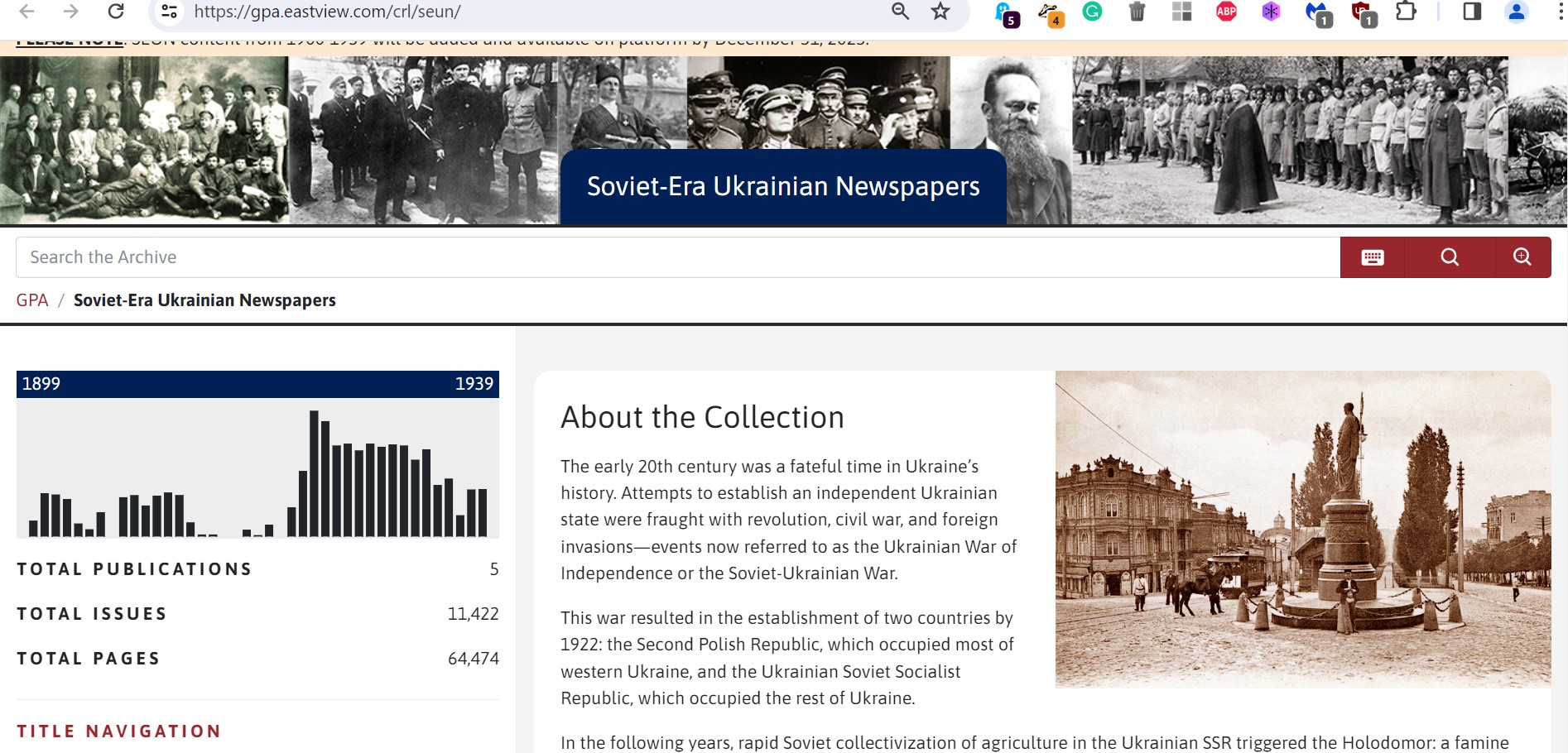
About the collection:
The early 20th century was a crucial time in Ukraine’s history, marked by attempts to establish an independent state, leading to the Ukrainian War of Independence. This conflict resulted in the creation of two countries by 1922: the Second Polish Republic in western Ukraine and the Ukrainian Soviet Socialist Republic in the rest of the country.
Following this, rapid Soviet collectivization in the Ukrainian SSR triggered the Holodomor, a famine that began in 1932 and claimed millions of lives.
The Soviet-Era Ukrainian Newspapers (SEUN) collection, with over 50,000 pages and five titles, documents Ukraine’s history during this turbulent period, including events leading up to WWII. It includes newspapers from Kyiv, Kharkiv, and Lviv, featuring content in both Ukrainian and Russian.
Primary Sources: International Herald Tribune Archive, 1887-2013
The Library now has access to the The International Herald Tribune Historical Archive (1887-2013), which features the complete run of the International Herald Tribune from its origins as the European Edition of The New York Herald and later the European Edition of the New York Herald Tribune. The archive ends with the last issue of the International Herald Tribune before its relaunch as the International New York Times.
Primary Sources: African American Newspapers in the South, 1870-1926
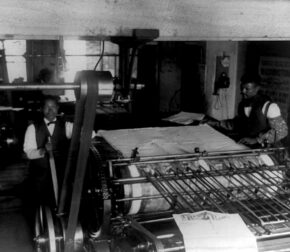 African American Newspapers in the South, 1870-1926 is a new addition to Accessible Archives. It documents the African American press in the South from Reconstruction through the Jim Crow period. Written by African Americans for African Americans, the first-hand reporting, editorials, and features kept readers abreast of current domestic and international events, often focusing on racial issues. The editors didn’t shy away from exposing racial discrimination and violence, including the emotionally laden topic of lynching. Yet, the newspapers also covered lighter fare, reporting on civic and religious events, politics, foreign affairs, local gossip, and more.
African American Newspapers in the South, 1870-1926 is a new addition to Accessible Archives. It documents the African American press in the South from Reconstruction through the Jim Crow period. Written by African Americans for African Americans, the first-hand reporting, editorials, and features kept readers abreast of current domestic and international events, often focusing on racial issues. The editors didn’t shy away from exposing racial discrimination and violence, including the emotionally laden topic of lynching. Yet, the newspapers also covered lighter fare, reporting on civic and religious events, politics, foreign affairs, local gossip, and more.
It includes all complete runs of representative newspapers from the District of Columbia, Georgia, Louisiana, North Carolina, Oklahoma, Tennessee, and West Virginia:
Athens Republique, 1921 – 1926
The Banner-Enterprise, 1883 – 1884
The Bee, 1882 – 1884
The Black Dispatch, 1917 – 1922
The Educator, 1874 – 1875
The Langston City Herald, 1892 – 1900
The Louisianian, 1870 – 1871
The Nashville Globe, 1907 – 1918
The National Forum, 1910
Pioneer Press, 1911 – 1917
The Republican, 1873 – 1875
Semi-Weekly Louisianian, 1871 – 1872
The Tulsa Star, 1913 –1921
Western World, 1903 – 1904
Primary Sources: American Prison Newspapers, 1800-2020: Voices from the Inside
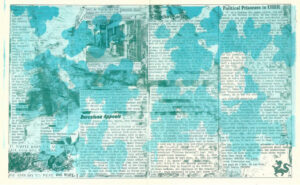 On March 24, 1800, Forlorn Hope became the first newspaper published within a prison by an incarcerated person. In the intervening 200 years, over 450 prison newspapers have been published from U.S. prisons. Some, like the Angolite and the San Quentin News, are still being published today. American Prison Newspapers will bring together hundreds of these periodicals from across the country into one collection that will represent penal institutions of all kinds, with special attention paid to women’s-only institutions.
On March 24, 1800, Forlorn Hope became the first newspaper published within a prison by an incarcerated person. In the intervening 200 years, over 450 prison newspapers have been published from U.S. prisons. Some, like the Angolite and the San Quentin News, are still being published today. American Prison Newspapers will bring together hundreds of these periodicals from across the country into one collection that will represent penal institutions of all kinds, with special attention paid to women’s-only institutions.
Development of the American Prison Newspapers collection began in July 2020 and will continue through 2022, with new content added regularly. The source material for the collection is being provided by numerous libraries and individuals from across the country. Currently there are nearly 100,000 pages available (of a planned 250,000 pages), representing at least one prison in 30 states.
Primary Sources: Accessible Archives

The Library has an ongoing subscription to Accessible Archives, which provides access to valuable newspaper content, county histories, early periodicals, books, and pamphlets. The collections can be browsed or searched (though the search interface is fairly clunky).
The most recent additions to Accessible Archives include:
- African American Newspapers, Part XIV: The Canadian Observer, 1914-1919
- Invention and Technology in America: American Inventor, 1878-1887
- America and World War I: American Military Camp Newspapers, Parts I and II
Trial: Black Life in America
Until March 15, the Library has trial access to Black Life in America, This resource consists of two parts: BLA (1704-1877): Arrival in America Through Reconstruction and BLA (1878-1975): Jim Crow Through Civil Rights. Both series are comprised of articles from over 20,000 mostly American, but some international newspapers about all manner of Black life in America.
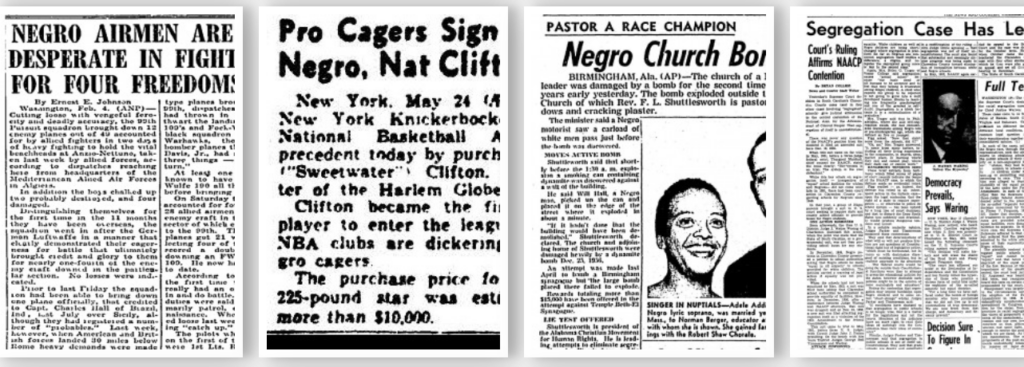
Primary Sources: Hispanic American Newspapers, 1808-1980

The Library has acquired Readex’s Hispanic American Newspapers, 1808-1980, a collection of Spanish- and English-language newspapers printed in the U.S. during the 19th and 20th centuries. The papers are sourced from the “Recovering the U.S. Hispanic Literary Heritage Project,” a national research effort directed by Nicolás Kanellos, Brown Foundation Professor of Hispanic Studies at the University of Houston.
The resource can be cross-searched with other Readex historical newspaper series, including Early American Newspapers, Caribbean Newspapers, and African American Newspapers, 1827-1998.
Primary Sources: Cumhuriyet Digital Archive
 The Library recently acquired the Cumhuriyet Digital Archive, which provides access to the complete run of the newspaper since its establishment in 1924. This information is provided on the digital platform: “…Cumhuriyet (“The Republic”) is the oldest secular Turkish daily newspaper and is widely considered one of the last remaining opposition newspapers in Turkey. Founded by journalist Yunus Nadi Abalıoğlu at the initiative of Mustafa Kemal Atatürk, Cumhuriyet was the first newspaper of the Turkish Republic and promoted a belief in democracy, secularism and the rule of law. According to the newspaper’s editorial principles: Cumhuriyet is an independent newspaper; it is the defender of nothing but the Republic, of democracy in the scientific and broad sense. It will fight every force that tries to overthrow the Republic and the notion and principles of democracy. It will endeavor for the embracing by society of the principle of secularism along the path of “Enlightenment” ushered in by Atatürk’s revolution and principles.”
The Library recently acquired the Cumhuriyet Digital Archive, which provides access to the complete run of the newspaper since its establishment in 1924. This information is provided on the digital platform: “…Cumhuriyet (“The Republic”) is the oldest secular Turkish daily newspaper and is widely considered one of the last remaining opposition newspapers in Turkey. Founded by journalist Yunus Nadi Abalıoğlu at the initiative of Mustafa Kemal Atatürk, Cumhuriyet was the first newspaper of the Turkish Republic and promoted a belief in democracy, secularism and the rule of law. According to the newspaper’s editorial principles: Cumhuriyet is an independent newspaper; it is the defender of nothing but the Republic, of democracy in the scientific and broad sense. It will fight every force that tries to overthrow the Republic and the notion and principles of democracy. It will endeavor for the embracing by society of the principle of secularism along the path of “Enlightenment” ushered in by Atatürk’s revolution and principles.”
New Latin American/ Latinx/ Chicanx Studies Database at UC Berkeley: Hispanic American Newspapers, 1808-1980
 We are glad to announce the purchase of access to Readex’s Hispanic American Newspapers, 1808-1980 database at UC Berkeley. This collection represents the single largest compilation of Spanish-language newspapers printed in the U.S. during the 19th and 20th centuries. The database provides access to thousands of titles and includes both English and Spanish language materials. The currently registered students and faculty can access the database using your UCB credentials here: Hispanic American Newspapers, 1890-1980.
We are glad to announce the purchase of access to Readex’s Hispanic American Newspapers, 1808-1980 database at UC Berkeley. This collection represents the single largest compilation of Spanish-language newspapers printed in the U.S. during the 19th and 20th centuries. The database provides access to thousands of titles and includes both English and Spanish language materials. The currently registered students and faculty can access the database using your UCB credentials here: Hispanic American Newspapers, 1890-1980.
The title list of the newspapers that are included in this collection can be accessed here. There are forty-four titles that were published in California. Some titles have extensive runs while the others have only a single issue that can be accessed. The image below is used for demonstrative and educational purposes only.
